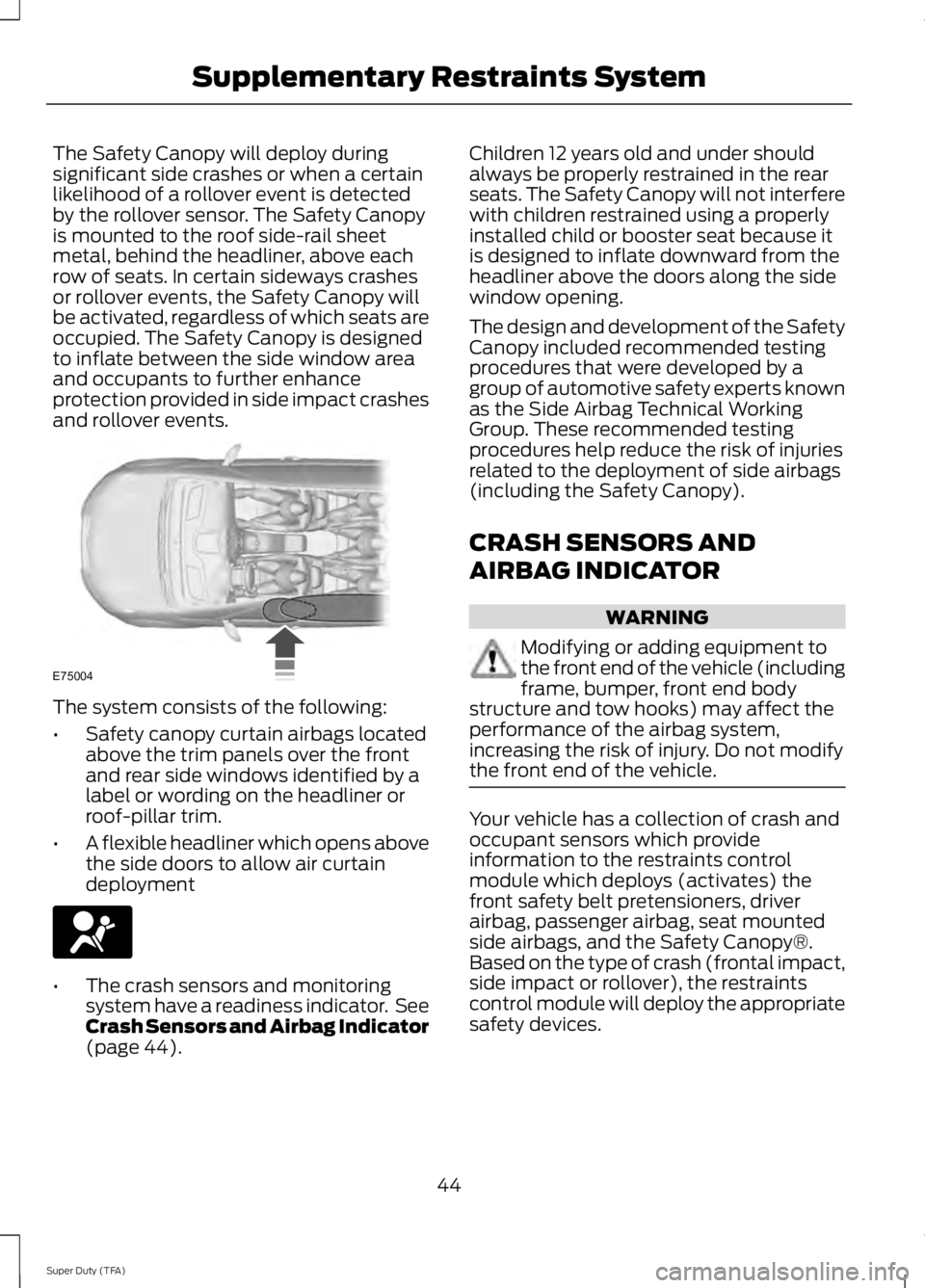2014 FORD F250 SUPER DUTY child restraint
[x] Cancel search: child restraintPage 47 of 460

The Safety Canopy will deploy duringsignificant side crashes or when a certainlikelihood of a rollover event is detectedby the rollover sensor. The Safety Canopyis mounted to the roof side-rail sheetmetal, behind the headliner, above eachrow of seats. In certain sideways crashesor rollover events, the Safety Canopy willbe activated, regardless of which seats areoccupied. The Safety Canopy is designedto inflate between the side window areaand occupants to further enhanceprotection provided in side impact crashesand rollover events.
The system consists of the following:
•Safety canopy curtain airbags locatedabove the trim panels over the frontand rear side windows identified by alabel or wording on the headliner orroof-pillar trim.
•A flexible headliner which opens abovethe side doors to allow air curtaindeployment
•The crash sensors and monitoringsystem have a readiness indicator. SeeCrash Sensors and Airbag Indicator(page 44).
Children 12 years old and under shouldalways be properly restrained in the rearseats. The Safety Canopy will not interferewith children restrained using a properlyinstalled child or booster seat because itis designed to inflate downward from theheadliner above the doors along the sidewindow opening.
The design and development of the SafetyCanopy included recommended testingprocedures that were developed by agroup of automotive safety experts knownas the Side Airbag Technical WorkingGroup. These recommended testingprocedures help reduce the risk of injuriesrelated to the deployment of side airbags(including the Safety Canopy).
CRASH SENSORS AND
AIRBAG INDICATOR
WARNING
Modifying or adding equipment tothe front end of the vehicle (includingframe, bumper, front end bodystructure and tow hooks) may affect theperformance of the airbag system,increasing the risk of injury. Do not modifythe front end of the vehicle.
Your vehicle has a collection of crash andoccupant sensors which provideinformation to the restraints controlmodule which deploys (activates) thefront safety belt pretensioners, driverairbag, passenger airbag, seat mountedside airbags, and the Safety Canopy®.Based on the type of crash (frontal impact,side impact or rollover), the restraintscontrol module will deploy the appropriatesafety devices.
44
Super Duty (TFA)
Supplementary Restraints SystemE75004
Page 257 of 460

GENERAL INFORMATION
Notice to utility vehicle and truckowners
WARNINGS
Utility vehicles have a significantlyhigher rollover rate than other typesof vehicles. To reduce the risk ofserious injury or death from a rollover orother crash you must avoid sharp turns andabrupt maneuvers, drive at safe speeds forthe conditions, keep tires properly inflated,never overload or improperly load yourvehicle, and make sure every passenger isproperly restrained.
In a rollover crash, an unbeltedperson is significantly more likely todie than a person wearing a seat belt.All occupants must wear seat belts andchildren/infants must use appropriaterestraints to minimize the risk of injury orejection.
Do not become overconfident in theability of four-wheel drive vehicles.Although a four-wheel drive vehiclemay accelerate better than a two-wheeldrive vehicle in low traction situations, itwon't stop any faster than two-wheel drivevehicles. Always drive at a safe speed.
Utility vehicles and trucks handledifferently than passenger cars in thevarious driving conditions that areencountered on streets, highways andoff-road. Utility vehicles and trucks are notdesigned for cornering at speeds as highas passenger cars any more than low-slungsports cars are designed to performsatisfactorily under off-road conditions.
Study your owner's manual and anysupplements for specific information aboutequipment features, instructions for safedriving and additional precautions toreduce the risk of an accident or seriousinjury.
Four-wheel drive system (ifequipped)
WARNING
Do not become overconfident in theability of four-wheel drive vehicles.Although a four-wheel drive vehiclemay accelerate better than a two-wheeldrive vehicle in low traction situations, itwon't stop any faster than two-wheel drivevehicles. Always drive at a safe speed.
A vehicle equipped with four-wheel drive(when selected) has the ability to use allfour wheels to power itself. This increasestraction which may enable you to safelydrive over terrain and road conditions thata conventional two-wheel drive vehiclecannot.
For four-wheel drive vehicles, a spare tireof a different size other than the tireprovided should never be used. A dissimilarspare tire size (other than the spare tireprovided) or major dissimilar tire sizedbetween the front and rear axles couldcause the four-wheel drive system to stopfunctioning and default to front-wheeldrive.
254
Super Duty (TFA)
Wheels and TiresE145298
Page 451 of 460

Car WashSee: Cleaning the Exterior...............................247Center Console..............................................129Removable Front Cupholders........................129Changing a Bulb............................................241Lamp Assembly Condensation.....................241Replacing Brake/Tail/Turn/Reverse LampBulbs..................................................................242Replacing Cargo Lamp and High-mountBrake Lamp Bulbs........................................242Replacing Fog Lamp Bulbs (IfEquipped..........................................................242Replacing Front Clearance andIdentification Lamp Bulbs (IfEquipped).........................................................241Replacing the License Plate LampBulb....................................................................243Changing a Fuse............................................214Fuses.......................................................................214Changing a Road Wheel............................279Dissimilar Spare Wheel and Tire AssemblyInformation......................................................279Location of the Spare Tire and Tools........280Removing the Spare Tire (With Spare TireCarrier Only)....................................................281Tire Change Procedure....................................282Changing the 12V Battery.........................235Battery Management System (IfEquipped)........................................................236Changing the Engine Air Filter.................245Changing the Wiper Blades......................237Checking MyKey System Status...............52Checking the Wiper Blades......................237Child Restraint and Safety BeltMaintenance.................................................35Child Safety.......................................................15General Information.............................................15Child Safety Locks..........................................27Child Seat Positioning..................................26Cleaning Leather Seats..............................251Cleaning Products........................................247Cleaning the Alloy Wheels........................251Cleaning the Engine....................................248Cleaning the Exhaust.................................249
Cleaning the Exterior...................................247Cleaning Plastic Exterior Parts.....................248Exterior Chrome..................................................247Stripes or Graphics (if equipped)................247Underbody...........................................................248Cleaning the Instrument Panel andInstrument Cluster Lens........................250Cleaning the Interior...................................250Cleaning the Windows and WiperBlades...........................................................249Clearing All MyKeys.......................................52Climate............................................................398Climate Control Voice Commands.............399Climate Control.............................................103Coolant CheckSee: Engine Coolant Check............................227Crash Sensors and Airbag Indicator.......44Creating a MyKey...........................................50Programming/Changing ConfigurableSettings................................................................51Cruise Control...................................................61Principle of Operation.......................................174Cruise controlSee: Using Cruise Control.................................174Customer Assistance................................208
D
Data Recording..................................................9Event Data Recording..........................................10Service Data Recording........................................9Daytime Running Lamps............................66Digital Radio..................................................306HD Radio Reception and StationTroubleshooting............................................307Direction Indicators........................................67Lane Change..........................................................67Driver and Passenger Airbags....................37Children and Airbags...........................................42Passenger Airbag On and Off Switch ..........37Proper Driver and Front Passenger SeatingAdjustment.........................................................41Driving Aids......................................................175Driving Hints..................................................200Driving Through Water................................201DRLSee: Daytime Running Lamps........................66
448
Super Duty (TFA)
Index